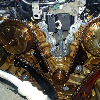? dont think I mentioned that anywhere lol.
Another question , do higher amperage alternators require more power to rotate them then lower amperage ones? For example a 100amp vs a 220amp? is it that the alternator simply generates more power from the same amount of rotational power? or that both the output and the rotational power required are higher?
How much work or power is required to turn the shaft depends on how many amps are being drawn from the alternator. If the battery is fully charged, or charged over the voltage that the regulator will charge to, then the regulator will not put much energy in the field coils. There will be very little rotational resistance, and very little current will flow in the output circuit.
If there is a heavy load on the system, the regulator will provide more current to the field coils. This will increase the power required to turn the shaft, and it will increase the current output at the alternator output terminal. Typically, the voltage regulator is set to charge to ~13.8 volts give or take a couple tenths of a volt.
For an 80 amp alternator, operating at full capacity of 80 amps, it usually takes about 1.8hp to 2hp to keep the thing spinning. If you have a 200 amp alternator operating a system where it's spinning at a constant speed, and there is a constant 80 amp load on the system, it will eventually balance out at an equilibrium where the alternator is making the required 80 amps and will take the same 1.8hp to 2hp to keep it spinning. If the 200 amp alternator is put in a system with a severely discharged battery, or with a 200 amp constant load, it will operate at 200 amps, and that will increase the power requirements to somewhere around 4.5 hp to keep the thing spinning.
If either the 80 amp alternator or the 200 amp alternator is connected to a battery which is fully charged (say maybe 14 volts, just above the 13.8 volts that the regulator has set as it's full charge target), then the regulator won't send much (any) current to the field coils, and the alternator will freewheel and make no current. At that point, you still need some power to keep it spinning to overcome friction in the bearings and in the belt/pulley system. But there will be no power required above that by the load of the alternator itself.
Generally speaking, amps * volts = power in watts, and you can convert that to horsepower by dividing watts by about 750. Actually, since there are always inefficiencies and losses, you'll probably get a better result dividing watts by about 600 (assuming about an 80% efficiency, with 20% losses to friction, interal resistance and "waste" heat).
Actually, Google will do the calculations and conversions for you, with the exact conversion factor. For example,
750 watts in hp will show you that the 750 watts is an approximation, and show exactly how many hp 750 watts equates to. You could go the other way, too,
1 hp in watts will give the actual conversion factor of 745.699872 watts = 1 hp.










